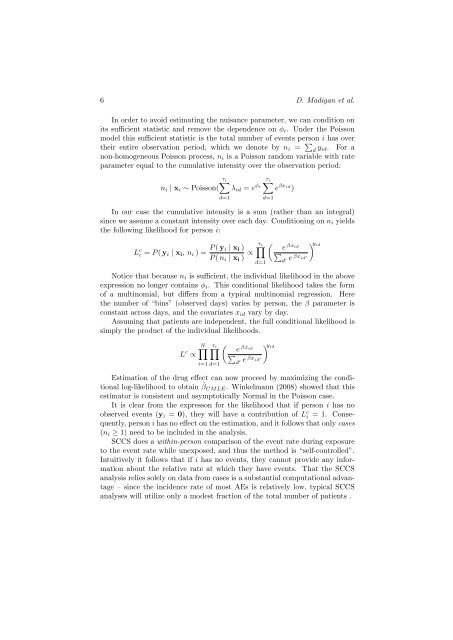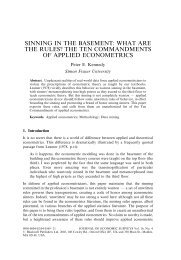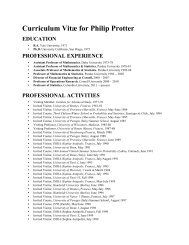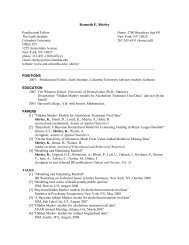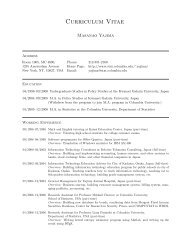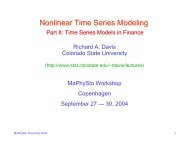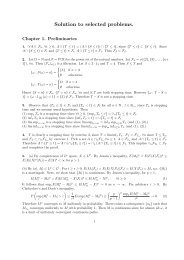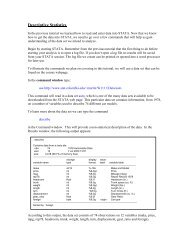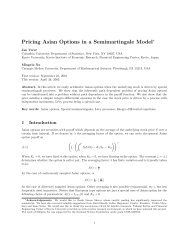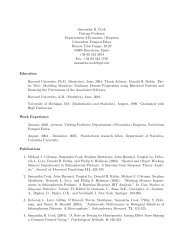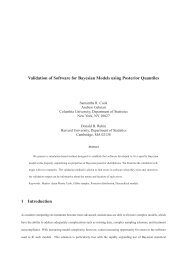The Self-Controlled Case Series - Department of Statistics ...
The Self-Controlled Case Series - Department of Statistics ...
The Self-Controlled Case Series - Department of Statistics ...
You also want an ePaper? Increase the reach of your titles
YUMPU automatically turns print PDFs into web optimized ePapers that Google loves.
6 D. Madigan et al.<br />
In order to avoid estimating the nuisance parameter, we can condition on<br />
its sufficient statistic and remove the dependence on φ i . Under the Poisson<br />
model this sufficient statistic is the total number <strong>of</strong> events person i has over<br />
their entire observation period, which we denote by n i = ∑ d y id. For a<br />
non-homogeneous Poisson process, n i is a Poisson random variable with rate<br />
parameter equal to the cumulative intensity over the observation period:<br />
∑τ i<br />
∑τ i<br />
n i | x i ∼ Poisson( λ id = e φi<br />
e βx id<br />
)<br />
d=1<br />
In our case the cumulative intensity is a sum (rather than an integral)<br />
since we assume a constant intensity over each day. Conditioning on n i yields<br />
the following likelihood for person i:<br />
L c i = P ( y i | x i , n i ) = P ( y τ<br />
i | x i )<br />
i<br />
P ( n i | x i ) ∝ ∏<br />
d=1<br />
d=1<br />
( e<br />
βx id<br />
) yid<br />
∑<br />
d e βx ′ id ′<br />
Notice that because n i is sufficient, the individual likelihood in the above<br />
expression no longer contains φ i . This conditional likelihood takes the form<br />
<strong>of</strong> a multinomial, but differs from a typical multinomial regression. Here<br />
the number <strong>of</strong> “bins” (observed days) varies by person, the β parameter is<br />
constant across days, and the covariates x id vary by day.<br />
Assuming that patients are independent, the full conditional likelihood is<br />
simply the product <strong>of</strong> the individual likelihoods.<br />
L c ∝<br />
N∏ ∏τ i<br />
i=1 d=1<br />
( e<br />
βx id<br />
) yid<br />
∑<br />
d e βx ′ id ′<br />
Estimation <strong>of</strong> the drug effect can now proceed by maximizing the conditional<br />
log-likelihood to obtain ˆβ CMLE . Winkelmann (2008) showed that this<br />
estimator is consistent and asymptotically Normal in the Poisson case.<br />
It is clear from the expresson for the likelihood that if person i has no<br />
observed events (y i = 0), they will have a contribution <strong>of</strong> L c i = 1. Consequently,<br />
person i has no effect on the estimation, and it follows that only cases<br />
(n i ≥ 1) need to be included in the analysis.<br />
SCCS does a within-person comparison <strong>of</strong> the event rate during exposure<br />
to the event rate while unexposed, and thus the method is “self-controlled”.<br />
Intuitively it follows that if i has no events, they cannot provide any information<br />
about the relative rate at which they have events. That the SCCS<br />
analysis relies solely on data from cases is a substantial computational advantage<br />
– since the incidence rate <strong>of</strong> most AEs is relatively low, typical SCCS<br />
analyses will utilize only a modest fraction <strong>of</strong> the total number <strong>of</strong> patients .


